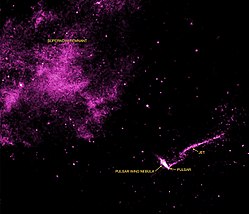IGR J11014−6103, also called the Lighthouse Nebula, is a pulsar wind nebula trailing the neutron star which has the longest relativistic jet observed in the Milky Way galaxy.

Description
editThe object consists of a neutron star with a radius of about 12 km, which formed about 10,000–30,000 years ago in a supernova explosion. The supernova explosion "kicked" the neutron star, which is now moving through space with a velocity of between 0.3% and 0.8% of the speed of light, faster than almost all other known runaway neutron stars. The pulsar is now about 60 light-years from the original supernova location.
The neutron star is the source of a relativistic helical jet, which is observed in X-rays but has no detected radio signature.[1] In the composite processed image (right) the neutron star pulsar is the point-like object with a pulsar wind nebula tail trailing behind it for about 3 light-years. The jet, aligned with the pulsar rotation axis, is perpendicular to the pulsar's trajectory and extends out over 37 light-years (about nine times the distance from the Sun to the nearest visible star). The estimated velocity of the jet is about 80% of the speed of light.
The star was initially presumed to be rapidly spinning but later measurements indicate that its spin rate is only 15.9 Hz.[2][3] This rather slow spin rate and the fact that there is no evidence of accretion suggests that the jet is neither rotation nor accretion powered. A counter-jet (not shown in the image) has been detected, but is much fainter, possibly due to relativistic beaming.[4][5] The origin of the glitch at about a third of the jet length is not known, but it might be due to the jet switching off and on or the jet orientation changing.
References
edit- ^ "Runaway pulsar has astronomers scratching their heads". News in Science (ABC Science). 2014-02-19.
- ^ Pavan, L.; Bordas, P.; Pühlhofer, G.; Filipović, M. D.; De Horta, A.; O'Brien, A.; Balbo, M.; Walter, R.; Bozzo, E.; Ferrigno, C.; Crawford, E.; Stella, L. (2014). "The long helical jet of the Lighthouse nebula, IGR J11014-6103" (PDF). Astronomy & Astrophysics. 562: A122. arXiv:1309.6792. Bibcode:2014A&A...562A.122P. doi:10.1051/0004-6361/201322588. S2CID 118845324. Long helical jet of Lighthouse nebula page 7
- ^ Halpern, J. P.; Tomsick, J. A.; Gotthelf, E. V.; Camilo, F.; Ng, C. -Y.; Bodaghee, A.; Rodriguez, J.; Chaty, S.; Rahoui, F. (2014). "Discovery of X-ray Pulsations from the INTEGRAL Source IGR J11014-6103". The Astrophysical Journal. 795 (2): L27. arXiv:1410.2332. Bibcode:2014ApJ...795L..27H. doi:10.1088/2041-8205/795/2/L27. S2CID 118637856.
- ^ Lindblom, L. (1984). "Limits on the gravitational redshift form neutron stars". Astrophysical Journal. 278: 364. Bibcode:1984ApJ...278..364L. doi:10.1086/161800.
- ^ Zhao, Xian-Feng; Jia, Huan-Yu (2014). "The surface gravitational redshift of the massive neutron star PSR J0348+0432" (PDF). Revista Mexicana de Astronomía y Astrofísica. 50 (1): 103–108. Bibcode:2014RMxAA..50..103Z. ISSN 0185-1101. Archived from the original (PDF) on 2017-05-10. Retrieved 2016-07-31.
External links
edit- The long helical jet of the Lighthouse nebula
- The Lighthouse nebula, NASA: Astronomy Picture of the Day, 2014 February 21
- A lighthouse pulsar (German)